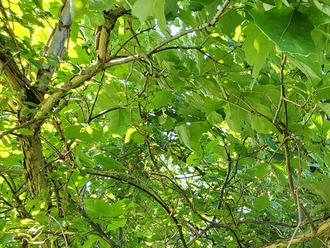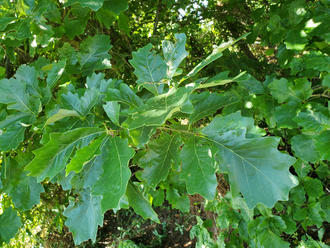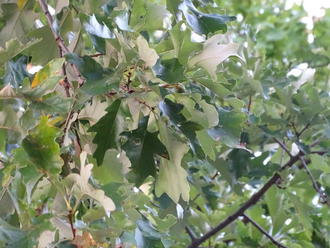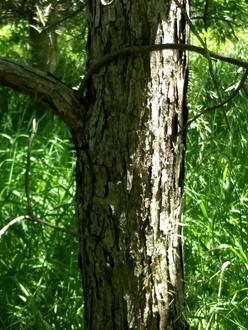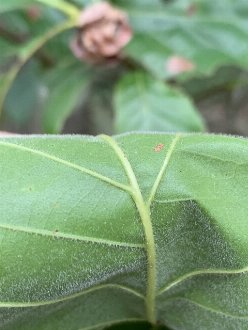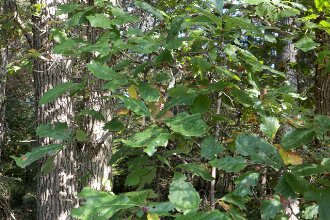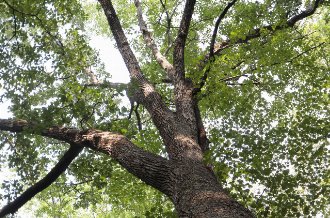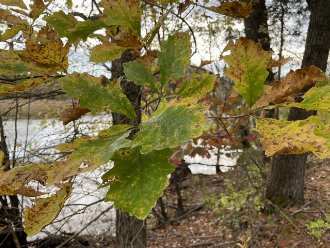Swamp White Oak (Quercus bicolor Willd.)
↑Summary
A large white oak native to eastern North America, favoring poorly-drained habitats.
↑Similar Plants
↑Habitat
Found in forested wetlands and swamp margins, floodplain forests, and in low-lying depressions and where clay soil prevents drainage.
Prefers lowland and poorly-drained habitats in conditions ranging from wet to mesic, and with acidic soils, but adaptable to a range of conditions, including silt and clay soils, loam, and sand. Most common on poorly-drained sites, which can occur due to a high water table, a well-drained surface soil being underlain by a gleysol, fine-textured mineral soils that are inherently poorly-drained, or muck or peaty soils in low-lying depressions. Sandy and well-drained soils are tolerated on sites with sufficient moisture, especially sites that flood regularly. However, absent from sites that are permanently flooded.
Moderately shade tolerant when young, and replaces early successional species, such as elm, ash, and cottonwood, on wet sites in the absence of disturbance, and can persist indefinitely on these sites. On well-drained sites, usually eventually replaced by other more shade-tolerant species such as hickory or beech.
Intolerant of severe drought but more drought tolerant than some wetland tree species. Often found on sites that are flooded in spring but dry in summer. Moderately tolerant of fire.
Usually a minor component of forests in which it occurs, but can be a co-dominant tree, often with pin oak (Quercus palustris), in swamps in the midwest, and also with American sweetgum (Liquidambar styraciflua) farther south.
↑Life Cycle
This tree is long-lived, and relatively fast-growing among oaks.
Seeds germinate directly after fall, without a period of cold dormancy, and quickly establish a taproot. Survival is best when acorns are buried by an animal; because the seeds are attractive as food, exposed seeds are usually eaten or moved to another location by an animal. Growth continues until it it becomes limited by cold temperatures and the tree goes dormant.
In the first few seasons, growth is slow, usually at most 6 inches a year, but often less if the tree is shaded or if the site is more water-saturated. Seedlings top-killed by herbivores may resprout multiple times, usually in subsequent years, before eventually growing into saplings. Once trees reach the sapling stage, growth accelerates greatly, especially if the tree has sufficient sun. Growth becomes faster than most species of the white oak group.
After the initial taproot, the tree develops a two-tiered root system, in which fine surface roots are utilized for aeration in times of flooding and high water tables, and deeper roots supply water when the water table is lower. This adaptation allows this tree to live longer than other species, such as silver maple, that inhabit the same habitat, as other species often rely on rapidly regrowing roots damaged by flooding, which works initially but eventually leads to rot and a poorly-organized root system.
Seed production usually begins at 20-30 years of age, peaks around 70-100 years. Trees can live 300-350 years.
Produces large acorn crops every 3-7 years. Dying trees also produce a large seed crop.
Seeds are primarily distributed by squirrels and sometimes by other animals, with gravity also being a factor; water may play a role in distributing some acorns downstream in floods. Blue jays, which cache seeds, can carry this species over a longer distance than squirrels.
When top-killed, such as by fire, young trees resprout from the root system, but resprouting ability declines with age and size, with trunks greater than 20 inches in diameter generally having only about a 5% chance of resprouting following top-kill.
↑Faunal Associations
This tree has high value to wildlife overall, mainly due to supporting a large number of insects, but also because of its seeds.
The acorns are eaten by squirrels, white-tailed deer, beavers, black bears, and a variety of larger birds, including wood duck, wild turkey, ruffed grouse, white-breasted nuthatch, blue jay, common grackle, rusty blackbird, brown thrasher, red-headed woodpecker, and red-bellied woodpecker. They also support two introduced birds, the ring-necked pheasant and monk parakeet. The foliage of young trees is occasionally browsed by deer or rabbits, usually early in the season when it is leafing out; mature leaves are unattractive to herbivores because of their tough texture and fuzzy undersides.
The tree also provides cover for birds and mammals. Even when uncommon, it is an important structural components of the bottomland forests in which it occurs, as it tends to have a straighter and sturdier trunk than other trees that grow in bottomlands.
This species supports a wide variety of insects, generally the same ones that eat other white oaks. These insects include several species of leafhopper of the Eratoneura genus, including three that prefer this species: Eratoneura accola, Eratoneura fergusoni, and Eratoneura mirifica, and at least three that do not. It also supports aphids, treehoppers, and a large number of beetles, most of which bore into the bark, and some of which eat the leaves. There are also wasps that form galls on this species. It also supports weevils and true bugs. The larvae of many species of butterfly and moth eat this and other white oaks.
Overall, both the density and diversity of insects supported by this species are high, which in turn makes this tree valuable for supporting nesting songbirds.
↑Uses
Occasionally used as a shade tree or landscaping plant, where it is valued for its bicolor leaves and wide adaptability. Highly tolerant of urban conditions, including soil compaction, but sometimes difficult to transplant and slow to establish. Once established, this tree makes an excellent landscaping plant for moist and poorly-drained sites, and is probably under-utilized. It is often a superior replacement for silver maple in urban areas and around homes, as it is longer-lived and less prone to dropping limbs. It is also a superior landscape tree for attracting birds.
It is also occasionally planted along highways, where it thrives in low-lying depressions, although it can sometimes be harmed by road salt.
Also used for timber, where it is usually lumped in with other white oaks. Its wood has many desireable properties, being hard, highly decay-resistant, and easy to glue, stain, and finish. The price is usually slightly higher than red oaks. It is used primarily for cabinets and furniture.
↑Related Plants
Closely related to and able to hybridize with white oak (Quercus alba) to produce Quercus ×jackiana, post oak (Quercus stellata), overcup oak (Quercus lyrata), and bur oak (Quercus macrocarpa).
↑Links & External Resources
• Swamp White Oak | The Wood Database (About This Site)
• Swamp White Oak | Fire Effects Information System (FEIS) (About This Site)
• Quercus bicolor (Swamp White Oak) | Illinois Wildflowers (About This Site)
• Quercus bicolor (Swamp White Oak) | USDA PLANTS Database (About This Site)
• Quercus bicolor | Go Botany (About This Site)
• Swamp White Oak | iNaturalist (About This Site)
• Quercus bicolor (Swamp White Oak) | Missouri Botanical Garden Plant Finder (About This Site)
• Swamp White Oak | Virginia Tech Dendrology Factsheets (About This Site)
• Swamp White Oak | Silvics of North America (About This Site)
• Quercus bicolor | Biota of North America Project (BONAP) (About This Site)
• Quercus bicolor | NatureServe Explorer (About This Site)
• Quercus bicolor | Flora of North America (About This Site)
• Swamp White Oak | Maryland Biodiversity Project (About This Site)
• Quercus bicolor Willdenow (Swamp White Oak) | Digital Atlas of the Virginia Flora (About This Site)







